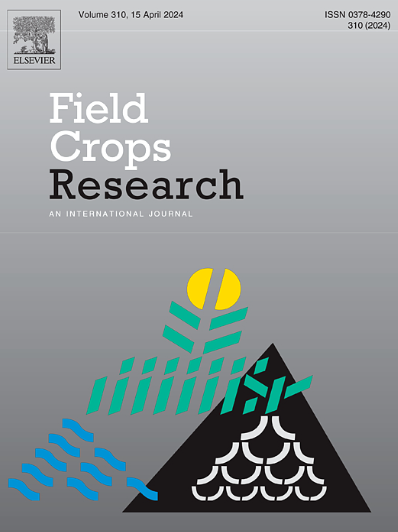通过改善农田氮素平衡和减少氮足迹提高西北干旱棉田生产力
IF 5.6
1区 农林科学
Q1 AGRONOMY
引用次数: 0
摘要
棉花是中国新疆最重要的经济作物。然而,由于过量施用氮肥,该地区正在经历相当大的环境压力。优化水氮管理实践是一种有效的方法,可以减少氮的损失,最大限度地减少环境污染的风险。目的评价不同施氮方式和灌溉方式对棉花氮素吸收的影响,比较不同施氮方式对农田氮素平衡和总氮足迹的影响。方法采用为期2年的田间试验,研究不同土壤基质势阈值(-30、- 20和- 10 kPa,分别为W1、W2和W3)和3种施氮量(200、300和400 kg ha - 1,分别为F1、F2和F3)下滴灌对棉花植株各部位氮素吸收和转运、土壤硝态氮积累以及氮素输入和输出的影响。该综合分析评估了每个系统的N平衡和足迹。结果过量灌溉和施肥能促进棉花根、茎、叶氮积累,但对棉铃氮积累无显著促进作用。氮素转运效率(NTE)和氮素生殖效率(NRE)分别降低25.1% %和26.1% %,对种子的贡献分别降低25.2% %和17.8% %。较高的施氮量降低了棉铃的氮素分配比例。较高的施肥和灌溉水平导致硝态氮分布更深、更广,增加了深层渗透和水平挥发的风险。NH3是棉田反应性氮损失的主要形式,损失范围为7.8 ~ 24.8 kg N ha−1。氮素平衡表明,随着灌溉强度的增加,过剩量减少,在250 kg N ha - 1以下出现缺氮,在350 kg N ha - 1以上出现过剩。结论- 20 kPa灌水下限促进了棉铃氮积累,保证了棉铃产量。根据系统的氮素平衡,建议设置275-307 kg N ha−1,以避免氮素缺乏或过量。该方法平衡了N环境友好性和生产,在该系统中实现了7.7-8.4 kg N t−1的N足迹。本研究为实现氮平衡和减少氮足迹提供了重要的见解,并为干旱地区棉花种植的发展提供了重要的前景。本文章由计算机程序翻译,如有差异,请以英文原文为准。
Enhancing cotton field productivity in arid northwest China through improved farm-level nitrogen balance and reduced nitrogen footprint
Contexts
Cotton is the most important economic crop in Xinjiang of China. However, due to the excessive application of nitrogen fertilizers, the region is experiencing considerable environmental stress. Optimizing water and nitrogen management practices presents an effective approach to mitigating nitrogen losses and minimizing the risk of environmental pollution.
Objectives
This study aims to evaluate the effects of various nitrogen (N) and irrigation strategies on N uptake by cotton plants, and compare the effectiveness of different management approaches on field-level N balance and overall N footprint.
Methods
A two-year field experiment was conducted to investigate the effects of drip irrigation under various soil matric potential (SMP) thresholds (-30, −20, and −10 kPa, as W1, W2 and W3) and three N rates (200, 300, and 400 kg ha−1, as F1, F2 and F3) on N uptake and translocation in various parts of the cotton plant, nitrate N accumulation in the soil, and N inputs and outputs. This comprehensive analysis evaluated the N balance and footprint for each system.
Results
The results showed that excessive irrigation and fertilization intensified N accumulation in the roots, stems, and leaves of cotton plants but did not significantly enhance N accumulation in cotton bolls. The N transport efficiency (NTE) decreased by 25.1 % and 26.1 %, and N reproductive efficiency (NRE) contributions to seeds decreased by 25.2 % and 17.8 %, respectively. Higher N application rates reduced the proportion of nitrogen allocated to cotton bolls. Higher fertilizer and irrigation levels led to a deeper and wider distribution of nitrate N, increasing the risk of deep percolation and horizontal volatilization. The NH3 emerged as the primary form of reactive N loss in cotton fields, ranging 7.8–24.8 kg N ha−1. The N balance indicated decreased surplus with intensified irrigation, N deficiency was observed at rates below 250 kg N ha−1, and excess N was noted above 350 kg N ha−1.
Conclusions
An irrigation lower limit of −20 kPa promoted increased N accumulation in cotton bolls and ensuring production. Based on the system's N balance, 275–307 kg N ha−1 was recommended to avoid N deficiency or excess. This approach balanced N environmental friendliness with production, achieving an N footprint of 7.7–8.4 kg N t−1 in this system.
Significance
This study provides critical insights for achieving N balance and minimizing N footprint, and holds substantial promise for the development of cotton cultivation in arid regions.
求助全文
通过发布文献求助,成功后即可免费获取论文全文。
去求助
来源期刊

Field Crops Research
农林科学-农艺学
CiteScore
9.60
自引率
12.10%
发文量
307
审稿时长
46 days
期刊介绍:
Field Crops Research is an international journal publishing scientific articles on:
√ experimental and modelling research at field, farm and landscape levels
on temperate and tropical crops and cropping systems,
with a focus on crop ecology and physiology, agronomy, and plant genetics and breeding.
 求助内容:
求助内容: 应助结果提醒方式:
应助结果提醒方式:


